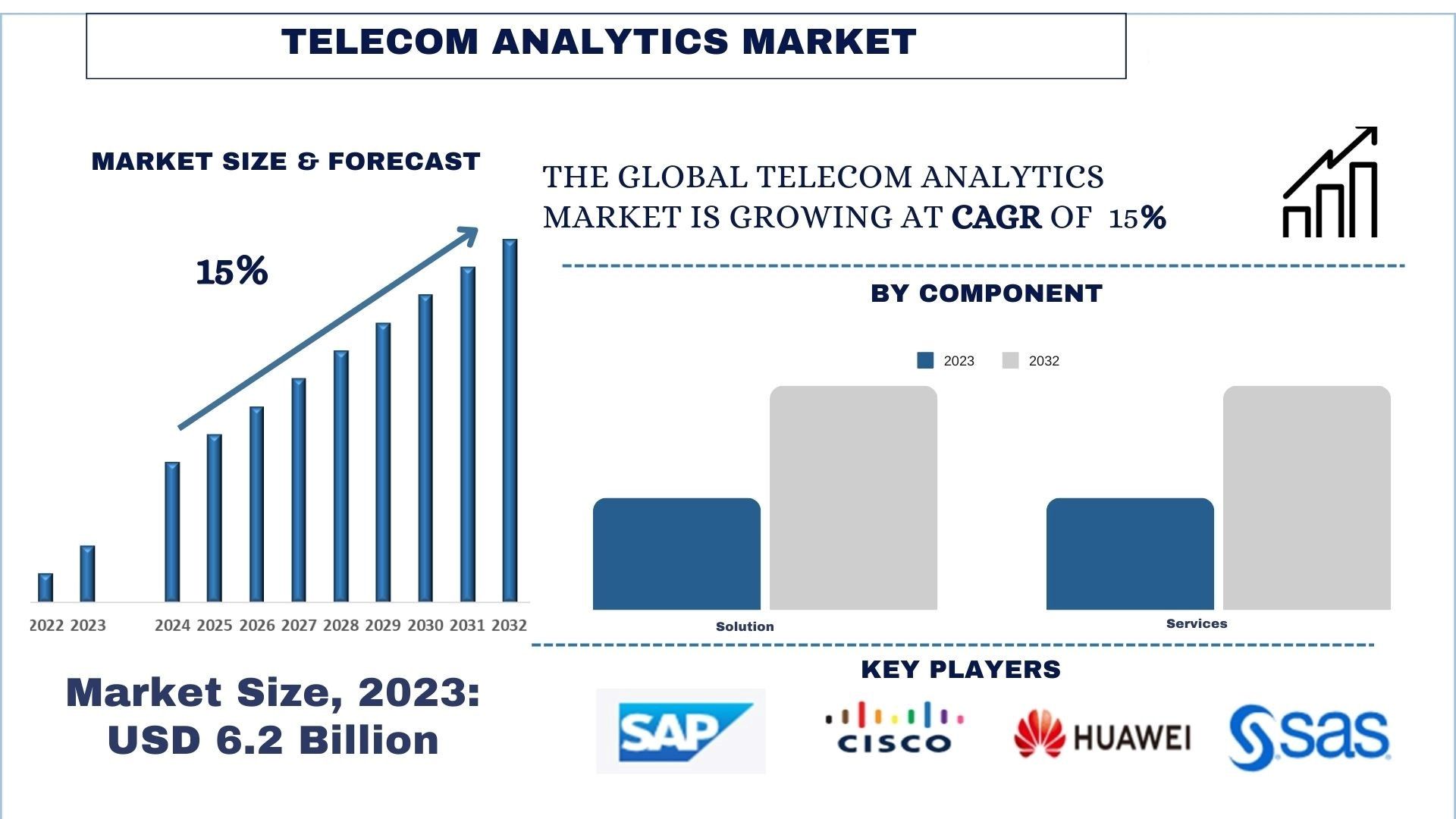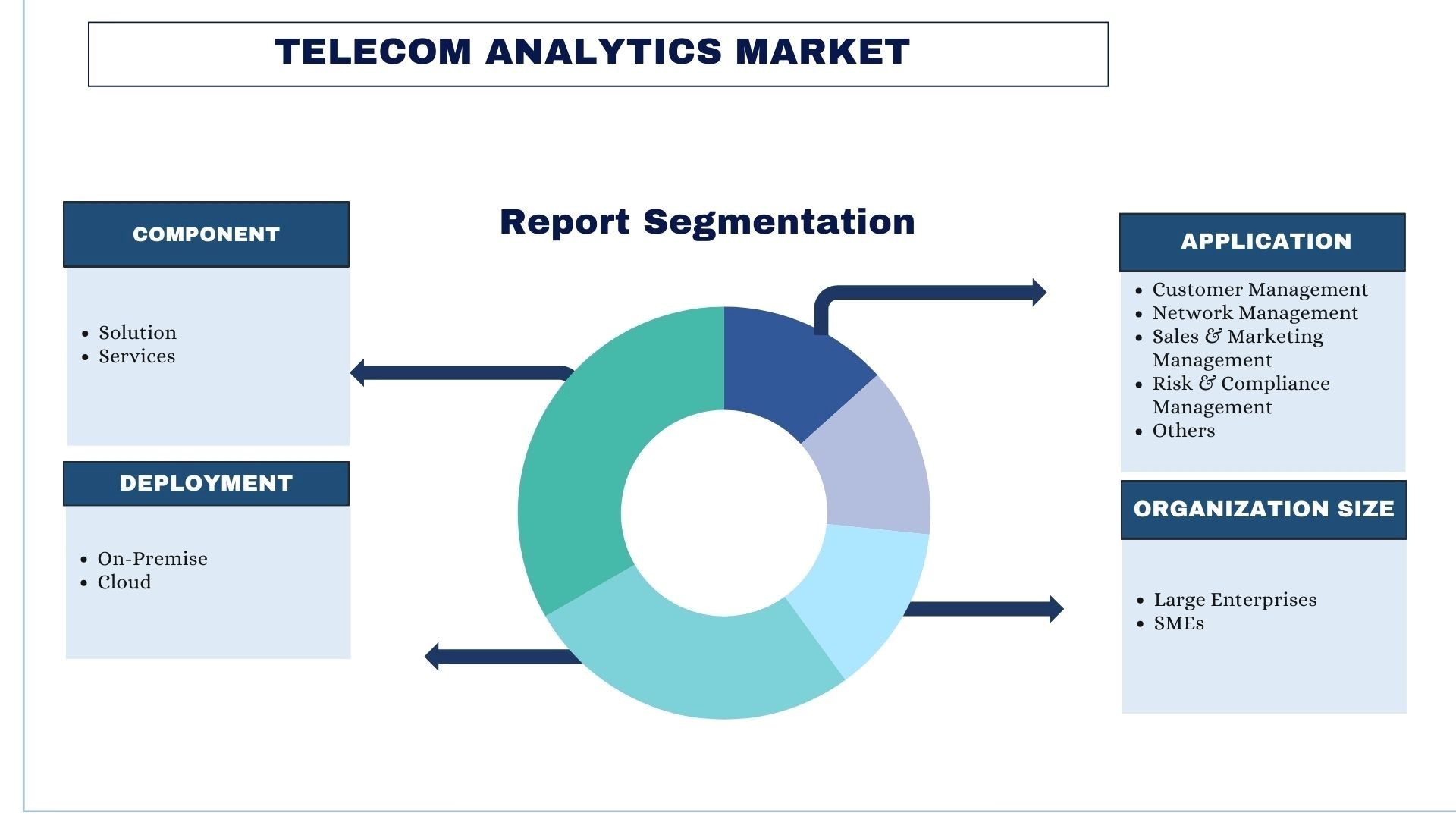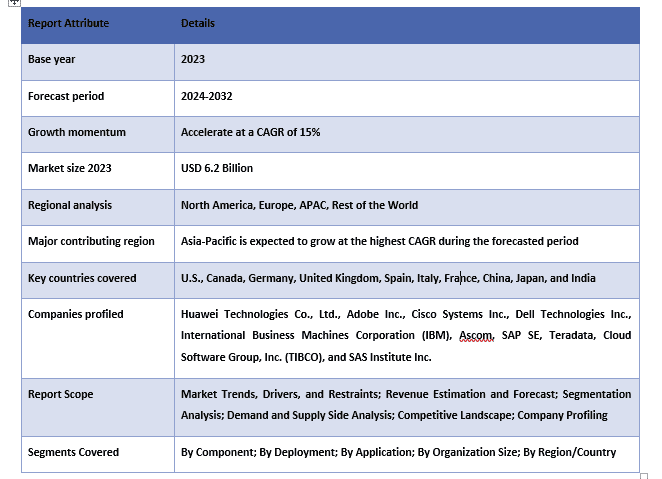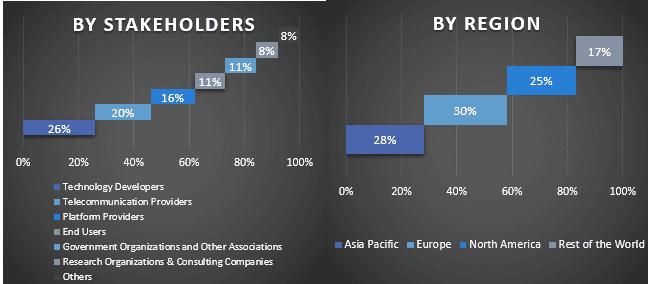- Accueil
- À propos de nous
- Industrie
- Services
- Lecture
- Contactez-nous
Marché de l'analyse des télécommunications : Analyse actuelle et prévisions (2024-2032)
Accent mis sur le composant (solution et services), le déploiement (cloud et sur site), la taille de l'organisation (grandes entreprises, petites et moyennes entreprises (PME)), l'application (gestion de la clientèle, gestion du réseau, gestion des ventes et du marketing, gestion des risques et de la conformité, et autres) ; région/pays.

Taille et prévisions du marché de l'analyse des télécommunications
Le marché de l'analyse des télécommunications était évalué à 6,2 milliards de dollars US en 2023 et devrait croître à un TCAC important d'environ 15 % au cours de la période de prévision (2024-2032). Cette croissance est principalement due à l'explosion des données et à la demande croissante d'une meilleure expérience client. Le secteur des télécommunications génère d'énormes quantités de données provenant des opérations de réseau, des interactions avec les clients et de l'utilisation des appareils. La prolifération des smartphones, des appareils IoT et des réseaux à haut débit a entraîné une explosion des données, créant des opportunités pour les entreprises de télécommunications d'exploiter l'analyse pour extraire des informations exploitables. De plus, l'analyse des télécommunications permet aux entreprises d'analyser le comportement, les préférences et les niveaux de satisfaction des clients afin de personnaliser les services, de résoudre les problèmes de manière proactive et d'améliorer l'expérience client globale.
Analyse du marché de l'analyse des télécommunications
L'analyse des télécommunications utilise des techniques et des technologies d'analyse de données avancées pour extraire des informations à partir des données de télécommunications. Ces données peuvent inclure des mesures de performance du réseau, des modèles de comportement des clients, des tendances d'utilisation des services et des informations de facturation. L'analyse des télécommunications vise à aider les entreprises à optimiser leurs opérations, à améliorer l'expérience client, à réduire le taux de désabonnement, à identifier les opportunités de revenus et à prendre des décisions fondées sur les données pour rester compétitives dans le secteur des télécommunications en évolution rapide.
Aperçus sur la segmentation du marché de l'analyse des télécommunications
Le marché de l'analyse des télécommunications est segmenté en solutions et services, en fonction des composants. En 2023, le segment des solutions détenait la part dominante du marché. Les solutions telles que l'analyse prédictive permettent aux opérateurs de télécommunications d'anticiper les besoins et les préférences des clients, ce qui conduit à des campagnes de marketing plus ciblées et à des services personnalisés. De plus, les solutions d'optimisation du réseau et de maintenance prédictive aident les entreprises de télécommunications à assurer une prestation de services transparente et à minimiser les temps d'arrêt, améliorant ainsi la satisfaction globale des clients.
Le marché de l'analyse des télécommunications est segmenté par déploiement en sur site et dans le cloud. Le segment du cloud détenait la part dominante du marché en 2023. Les plateformes d'analyse basées sur le cloud offrent une évolutivité et une flexibilité, permettant aux entreprises de télécommunications de gérer et d'analyser efficacement de vastes volumes de données générées à partir de diverses sources, notamment les interactions avec les clients, les mesures de performance du réseau et les processus opérationnels. Par exemple, les principaux acteurs des télécommunications comme AT&T et Verizon ont migré leurs charges de travail d'analyse vers des plateformes cloud comme AWS et Azure pour exploiter les capacités d'analyse avancées et accélérer l'innovation dans des domaines tels que le déploiement du réseau 5G et les services IoT.
Par application, le marché de l'analyse des télécommunications est segmenté en gestion de la clientèle, gestion du réseau, gestion des ventes et du marketing, gestion des risques et de la conformité et autres. Le segment de la gestion du réseau détenait la part dominante du marché en 2023. La domination du segment de la gestion du réseau est motivée par la complexité croissante des réseaux de télécommunications et l'importance croissante d'assurer une performance et une fiabilité optimales. Avec la prolifération des appareils connectés et la croissance exponentielle du trafic de données, les opérateurs de télécommunications s'appuient sur des outils d'analyse avancés pour surveiller la performance du réseau en temps réel, détecter les anomalies ou les menaces de sécurité et résoudre de manière proactive les problèmes afin d'éviter les interruptions de service. Par exemple, les géants des télécommunications comme Ericsson et Nokia offrent des solutions d'analyse de réseau qui permettent aux opérateurs d'optimiser l'allocation des ressources, d'améliorer la planification de la capacité du réseau et de fournir un service de qualité supérieure aux utilisateurs finaux.
Par taille d'organisation, le marché de l'analyse des télécommunications est segmenté en grandes entreprises et PME. Le segment des grandes entreprises détenait la part dominante du marché en 2023. La domination des grandes entreprises sur le marché de l'analyse des télécommunications peut être attribuée à leurs investissements importants dans l'infrastructure technologique et les ressources pour soutenir des initiatives d'analyse sophistiquées. Les grands opérateurs de télécommunications tels que Verizon, AT&T et Vodafone ont mis en place des équipes d'analyse dédiées et des centres d'excellence pour stimuler l'innovation et développer des capacités d'analyse avancées en interne.

L'Amérique du Nord détenait une part dominante du marché en 2023
La part de marché dominante de l'Amérique du Nord est alimentée par plusieurs facteurs, notamment l'infrastructure de télécommunications avancée de la région, sa base de consommateurs férus de technologie et un environnement réglementaire favorable. Les principales entreprises de télécommunications en Amérique du Nord, telles que Verizon et AT&T, ont été à l'avant-garde de l'exploitation de l'analyse pour stimuler la transformation numérique et améliorer l'expérience client. Par exemple, Verizon utilise l'analyse pour optimiser la performance de son réseau, améliorer la fiabilité du service et fournir des offres innovantes comme l'informatique en périphérie et la solution IoT.

Aperçu de l'industrie de l'analyse des télécommunications
Le marché de l'analyse des télécommunications est concurrentiel et fragmenté, avec plusieurs acteurs du marché mondiaux et internationaux. Les principaux acteurs adoptent différentes stratégies de croissance pour renforcer leur présence sur le marché, telles que des partenariats, des accords, des collaborations, des lancements de nouveaux produits, des expansions géographiques et des fusions et acquisitions. Les principaux acteurs opérant sur le marché sont Huawei Technologies Co., Ltd., Adobe Inc., Cisco Systems Inc., Dell Technologies Inc., International Business Machines Corporation (IBM), Ascom, SAP SE, Teradata, Cloud Software Group, Inc. (TIBCO) et SAS Institute Inc.
Actualités du marché de l'analyse des télécommunications
En avril 2022, NOKIA a dévoilé son intention de fournir 7250 routeurs d'interconnexion basés sur châssis IXR pour prendre en charge les applications 400GE à haute densité dans l'architecture réseau de « niveau 2 » de Microsoft. Cette initiative vise à améliorer l'évolutivité, l'agilité et la mise en réseau résiliente dans l'environnement des centres de données. De telles avancées permettent aux entreprises d'analyser efficacement de vastes quantités de données, ce qui se traduit par un meilleur service à la clientèle et des perspectives accrues de fidélisation de la clientèle. Par conséquent, cela devrait stimuler la croissance du marché de l'analyse des télécommunications.
En mars 2022, HCL et IBM ont annoncé un effort de collaboration pour établir un centre d'excellence, axé sur la fourniture de technologies de modernisation du réseau aux opérateurs de télécommunications. Cette initiative vise à aider les clients des télécommunications à transformer leurs réseaux, notamment les réseaux vRAN, ORAN, privés, la modernisation en périphérie et la 5G. L'adoption de telles technologies devrait stimuler la croissance du marché en permettant aux opérateurs de s'adapter efficacement aux exigences évolutives du réseau.
En juin 2021, AT&T a révélé son intention de faire passer son réseau 5G à Microsoft Azure, dans le but d'améliorer la vitesse, la sécurité, la rentabilité et l'innovation. Avec l'augmentation du volume de données, les entreprises de télécommunications se tournent vers les fournisseurs de services cloud et utilisent l'analyse pour améliorer la sécurité et la gestion des données. Ces avancées devraient avoir un impact positif sur la croissance du marché, car les opérateurs exploitent des solutions basées sur le cloud pour relever les défis posés par l'augmentation des demandes de données.
Couverture du rapport sur le marché de l'analyse des télécommunications

Raisons d'acheter ce rapport :
- L'étude comprend une analyse de la taille et des prévisions du marché validée par des experts clés authentifiés du secteur.
- Le rapport présente un aperçu rapide de la performance globale de l'industrie en un coup d'œil.
- Le rapport couvre une analyse approfondie des pairs importants du secteur, en mettant l'accent sur les principaux indicateurs financiers, les portefeuilles de produits, les stratégies d'expansion et les développements récents.
- Examen détaillé des moteurs, des contraintes, des tendances clés et des opportunités qui prévalent dans l'industrie.
- L'étude couvre de manière exhaustive le marché à travers différents segments.
- Analyse approfondie au niveau régional de l'industrie.
Options de personnalisation :
Le marché mondial de l'analyse des télécommunications peut être davantage personnalisé selon les exigences ou tout autre segment de marché. En outre, UMI comprend que vous pouvez avoir vos propres besoins commerciaux, n'hésitez donc pas à communiquer avec nous pour obtenir un rapport qui répond parfaitement à vos exigences.
Table des matières
Méthodologie de recherche pour l'analyse du marché de l'analyse des télécommunications (2024-2032)
L'analyse du marché historique, l'estimation du marché actuel et la prévision du marché futur du marché mondial de l'analyse des télécommunications ont été les trois principales étapes entreprises pour créer et analyser l'adoption de l'analyse des télécommunications dans les principales régions du monde. Une recherche secondaire exhaustive a été menée pour collecter les chiffres du marché historique et estimer la taille actuelle du marché. Deuxièmement, pour valider ces informations, de nombreux résultats et hypothèses ont été pris en compte. De plus, des entretiens primaires exhaustifs ont également été menés avec des experts de l'industrie à travers la chaîne de valeur du marché mondial de l'analyse des télécommunications. Après l'hypothèse et la validation des chiffres du marché par le biais d'entretiens primaires, nous avons utilisé une approche descendante/ascendante pour prévoir la taille complète du marché. Par la suite, des méthodes de ventilation du marché et de triangulation des données ont été adoptées pour estimer et analyser la taille du marché des segments et sous-segments de l'industrie concernée. La méthodologie détaillée est expliquée ci-dessous :
Analyse de la taille du marché historique
Étape 1 : Étude approfondie des sources secondaires :
Une étude secondaire détaillée a été menée pour obtenir la taille du marché historique du marché de l'analyse des télécommunications à partir de sources internes de l'entreprise, telles que les rapports annuels et les états financiers, les présentations de performances, les communiqués de presse, etc., et de sources externes, notamment les revues, les actualités et les articles, les publications gouvernementales, les publications des concurrents, les rapports sectoriels, les bases de données tierces et d'autres publications crédibles.
Étape 2 : Segmentation du marché :
Après avoir obtenu la taille du marché historique du marché de l'analyse des télécommunications, nous avons mené une analyse secondaire détaillée pour recueillir des informations sur le marché historique et la part des différents segments et sous-segments pour les principales régions. Les principaux segments inclus dans le rapport sont les composants, le déploiement, l'application et la taille de l'organisation. D'autres analyses au niveau des pays ont été menées pour évaluer l'adoption globale.
Étape 3 : Analyse des facteurs :
Après avoir acquis la taille du marché historique des différents segments et sous-segments, nous avons mené une analyse détaillée des facteurs pour estimer la taille actuelle du marché de l'analyse des télécommunications. De plus, nous avons effectué une analyse des facteurs à l'aide de variables dépendantes et indépendantes telles que les composants, le déploiement, l'application et la taille de l'organisation du marché de l'analyse des télécommunications. Une analyse approfondie a été menée pour les scénarios de demande et d'offre en tenant compte des principaux partenariats, des fusions et acquisitions, de l'expansion des activités et des lancements de produits dans le secteur du marché de l'analyse des télécommunications à travers le monde.
Estimation et prévision de la taille actuelle du marché
Taille actuelle du marché : Sur la base des informations exploitables tirées des 3 étapes ci-dessus, nous sommes parvenus à la taille actuelle du marché, aux principaux acteurs du marché mondial de l'analyse des télécommunications et aux parts de marché des segments. Tous les pourcentages de parts requis et les ventilations du marché ont été déterminés à l'aide de l'approche secondaire mentionnée ci-dessus et ont été vérifiés par le biais d'entretiens primaires.
Estimation et prévisions : Pour l'estimation et les prévisions du marché, des pondérations ont été attribuées à différents facteurs, notamment les moteurs et les tendances, les contraintes et les opportunités disponibles pour les parties prenantes. Après avoir analysé ces facteurs, les techniques de prévision pertinentes, c'est-à-dire l'approche descendante/ascendante, ont été appliquées pour arriver aux prévisions de marché pour 2032 pour différents segments et sous-segments sur les principaux marchés mondiaux. La méthodologie de recherche adoptée pour estimer la taille du marché comprend :
- La taille du marché de l'industrie, en termes de revenus (USD) et le taux d'adoption du marché de l'analyse des télécommunications sur les principaux marchés nationaux
- Tous les pourcentages de parts, les divisions et les ventilations des segments et sous-segments de marché
- Les principaux acteurs du marché mondial de l'analyse des télécommunications en termes de produits offerts. De plus, les stratégies de croissance adoptées par ces acteurs pour être compétitifs sur le marché en croissance rapide
Validation de la taille du marché et de la part de marché Recherche primaire
Des entretiens approfondis ont été menés avec les principaux leaders d'opinion (KOL), notamment les cadres supérieurs (CXO/VP, chef des ventes, chef du marketing, chef des opérations, chef régional, chef de pays, etc.) dans les principales régions. Les résultats de la recherche primaire ont ensuite été résumés, et une analyse statistique a été effectuée pour prouver l'hypothèse énoncée. Les contributions de la recherche primaire ont été consolidées avec les résultats secondaires, transformant ainsi l'information en informations exploitables.
Répartition des participants primaires dans différentes régions

Ingénierie de marché
La technique de triangulation des données a été utilisée pour compléter l'estimation globale du marché et pour arriver à des chiffres statistiques précis pour chaque segment et sous-segment de la batterie au lithium-silicium mondiale. Les données ont été divisées en plusieurs segments et sous-segments après avoir étudié divers paramètres et tendances dans les domaines de la capacité, de l'application et des composants dans la batterie au lithium-silicium mondiale.
L'objectif principal de l'étude du marché mondial de l'analyse des télécommunications
Les tendances actuelles et futures du marché mondial de l'analyse des télécommunications ont été mises en évidence dans l'étude. Les investisseurs peuvent obtenir des informations stratégiques pour baser leur discrétion en matière d'investissements sur l'analyse qualitative et quantitative effectuée dans l'étude. Les tendances actuelles et futures du marché ont déterminé l'attractivité globale du marché au niveau régional, offrant ainsi une plateforme au participant industriel pour exploiter le marché inexploité afin de bénéficier d'un avantage de premier arrivé. Les autres objectifs quantitatifs des études comprennent :
- Analyser la taille actuelle et prévue du marché de l'analyse des télécommunications en termes de valeur (USD). Analyser également la taille actuelle et prévue du marché des différents segments et sous-segments.
- Les segments de l'étude comprennent les domaines des composants, du déploiement, de l'application et de la taille de l'organisation.
- Définir et analyser le cadre réglementaire de l'analyse des télécommunications
- Analyser la chaîne de valeur impliquée avec la présence de divers intermédiaires, ainsi qu'analyser les comportements des clients et des concurrents de l'industrie.
- Analyser la taille actuelle et prévue du marché de l'analyse des télécommunications pour la région principale.
- Les principaux pays des régions étudiées dans le rapport comprennent l'Asie-Pacifique, l'Europe, l'Amérique du Nord et le reste du monde
- Profils d'entreprises du marché de l'analyse des télécommunications et stratégies de croissance adoptées par les acteurs du marché pour se maintenir sur le marché en croissance rapide
- Analyse approfondie au niveau régional de l'industrie
Questions Fréquemment Posées FAQ
Q1 : Quelle est la taille actuelle du marché et le potentiel de croissance du marché de l’analyse des télécommunications ?
Q2 : Quels sont les principaux facteurs de croissance du marché de l’analyse des télécommunications ?
Q3 : Quel segment détient la plus grande part du marché de l’analyse des télécommunications par composant ?
Q4 : Quelles sont les technologies et les tendances émergentes sur le marché de l’analyse des télécommunications ?
Q5 : Quelle région dominera le marché de l'analyse des télécommunications ?
Connexes Rapports
Les clients qui ont acheté cet article ont également acheté










